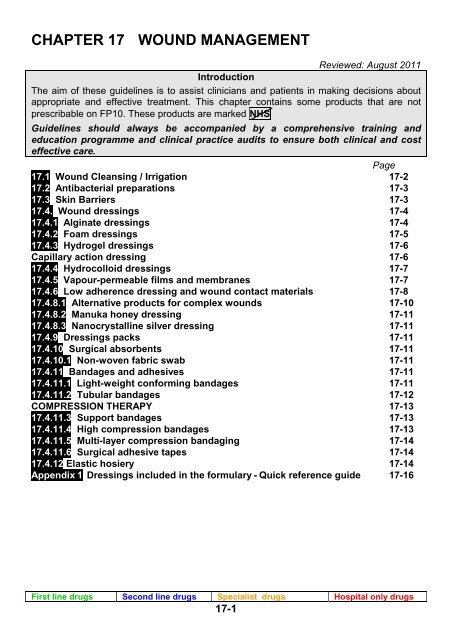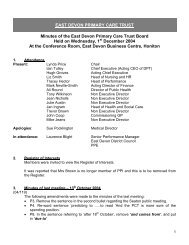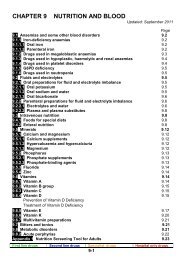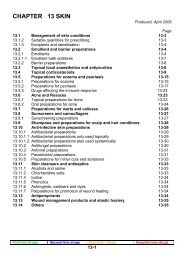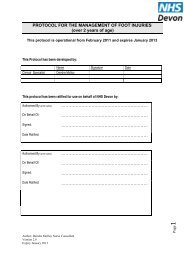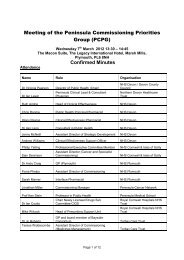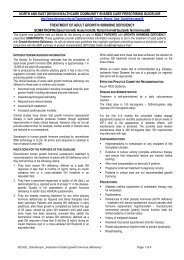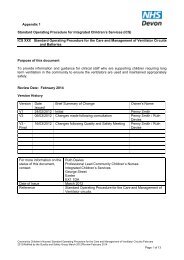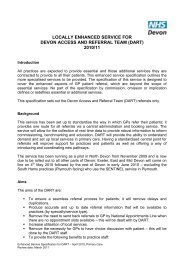CHAPTER 17 WOUND MANAGEMENT - NHS Devon
CHAPTER 17 WOUND MANAGEMENT - NHS Devon
CHAPTER 17 WOUND MANAGEMENT - NHS Devon
You also want an ePaper? Increase the reach of your titles
YUMPU automatically turns print PDFs into web optimized ePapers that Google loves.
<strong>CHAPTER</strong> <strong>17</strong> <strong>WOUND</strong> <strong>MANAGEMENT</strong><br />
Reviewed: August 2011<br />
Introduction<br />
The aim of these guidelines is to assist clinicians and patients in making decisions about<br />
appropriate and effective treatment. This chapter contains some products that are not<br />
prescribable on FP10. These products are marked <strong>NHS</strong><br />
Guidelines should always be accompanied by a comprehensive training and<br />
education programme and clinical practice audits to ensure both clinical and cost<br />
effective care.<br />
Page<br />
<strong>17</strong>.1 Wound Cleansing / Irrigation <strong>17</strong>-2<br />
<strong>17</strong>.2 Antibacterial preparations <strong>17</strong>-3<br />
<strong>17</strong>.3 Skin Barriers <strong>17</strong>-3<br />
<strong>17</strong>.4. Wound dressings <strong>17</strong>-4<br />
<strong>17</strong>.4.1 Alginate dressings <strong>17</strong>-4<br />
<strong>17</strong>.4.2 Foam dressings <strong>17</strong>-5<br />
<strong>17</strong>.4.3 Hydrogel dressings <strong>17</strong>-6<br />
Capillary action dressing <strong>17</strong>-6<br />
<strong>17</strong>.4.4 Hydrocolloid dressings <strong>17</strong>-7<br />
<strong>17</strong>.4.5 Vapour-permeable films and membranes <strong>17</strong>-7<br />
<strong>17</strong>.4.6 Low adherence dressing and wound contact materials <strong>17</strong>-8<br />
<strong>17</strong>.4.8.1 Alternative products for complex wounds <strong>17</strong>-10<br />
<strong>17</strong>.4.8.2 Manuka honey dressing <strong>17</strong>-11<br />
<strong>17</strong>.4.8.3 Nanocrystalline silver dressing <strong>17</strong>-11<br />
<strong>17</strong>.4.9 Dressings packs <strong>17</strong>-11<br />
<strong>17</strong>.4.10 Surgical absorbents <strong>17</strong>-11<br />
<strong>17</strong>.4.10.1 Non-woven fabric swab <strong>17</strong>-11<br />
<strong>17</strong>.4.11 Bandages and adhesives <strong>17</strong>-11<br />
<strong>17</strong>.4.11.1 Light-weight conforming bandages <strong>17</strong>-11<br />
<strong>17</strong>.4.11.2 Tubular bandages <strong>17</strong>-12<br />
COMPRESSION THERAPY <strong>17</strong>-13<br />
<strong>17</strong>.4.11.3 Support bandages <strong>17</strong>-13<br />
<strong>17</strong>.4.11.4 High compression bandages <strong>17</strong>-13<br />
<strong>17</strong>.4.11.5 Multi-layer compression bandaging <strong>17</strong>-14<br />
<strong>17</strong>.4.11.6 Surgical adhesive tapes <strong>17</strong>-14<br />
<strong>17</strong>.4.12 Elastic hosiery <strong>17</strong>-14<br />
Appendix 1 Dressings included in the formulary - Quick reference guide <strong>17</strong>-16<br />
First line drugs Second line drugs Specialist drugs Hospital only drugs<br />
<strong>17</strong>-1
Introduction<br />
The key to successful wound management is high quality, evidence based,<br />
consistent management and treatment by trained and skilled practitioners<br />
A variety of sizes of dressing that will be suitable for most patients have been included,<br />
please try to ensure you order and use the most appropriate size for the patient’s wound to<br />
reduce wastage.<br />
Please ensure you order only what the patient requires and do not change the type of<br />
product used frequently to prevent large stocks building up in the patient’s home.<br />
Commonly used sizes of first line dressings are shown in green and are more likely to be<br />
readily obtainable from community pharmacy. These sizes should suffice for the majority of<br />
wounds and should be selected where possible.<br />
Heel and sacral dressings have not been included as it is usually possible to get a better<br />
dressing fit for most patients by cutting and moulding flat dressings to the correct shape.<br />
In Torbay, a Dressings Request form has been produced to assist healthcare workers in<br />
providing appropriate information to prescribers of dressings.<br />
<strong>17</strong>.1 Wound Cleansing / Irrigation<br />
Refer to Chapter 13 for disinfectants and cleansers section<br />
Drinking water (Tap) ♦ (see note below)<br />
Sterile water<br />
Sodium chloride ♦ Irripod ®<br />
♦ Irriclens ®<br />
Notes:<br />
1. Wounds that are healthy and free from debris do not require cleansing. Routine<br />
cleansing of a healthy wound removes the beneficial chemicals, can damage delicate<br />
tissue, will delay wound healing and can be painful.<br />
2. However, all traumatic wounds are considered contaminated and should be cleaned<br />
thoroughly, rinsing the wound under running warm water is very effective.<br />
3. Good quality, warm drinking water (including tap water) is suitable for irrigating the<br />
majority of wounds. An appropriately clean container should be used.<br />
4. Warm isotonic saline may help where the wound cleansing process is painful or<br />
uncomfortable.<br />
5. For acute post-operative wounds and for immunocompromised patients, sterile water<br />
or saline should be used. [Nice CG74]<br />
6. Antiseptics may be appropriate in heavily contaminated wounds or immunosuppressed<br />
patients.<br />
7. Do not use antiseptics containing cetrimide as it has been shown to have a toxic effect<br />
on fibroblasts. Its use should be restricted to A&E only, where a detergent effect is<br />
useful for removing foreign material, such as dirt or tar from wounds.<br />
8. It is not necessary to dry the wound bed following cleansing as this will cause trauma<br />
to the wound bed and damage delicate tissue.<br />
First line drugs Second line drugs Specialist drugs Hospital only drugs<br />
<strong>17</strong>-2
<strong>17</strong>.2 Antibacterial preparations<br />
Refer to Chapter 13 for antibacterial preparations section<br />
♦ 0.75% Gel 40g<br />
Metronidazole (Metrogel ® )<br />
Silver sulfadiazine ♦ 1% Cream 20g, 50g<br />
♦ 250g, 500g Jars for hospital use only<br />
Notes:<br />
1. Topical antibiotic preparations are used to reduce levels of bacteria within the wound<br />
bed and in burns to prevent infection. They are frequent sensitisers, can encourage<br />
the development of resistant bacteria and have no effect on healing. Therefore their<br />
use should be carefully restricted.<br />
2. Wound swabs should be taken only when there is clinical evidence of infection. Refer<br />
to Wound Management policy.<br />
3. Metronidazole gel can be useful in the management of malodorous fungating tumours<br />
depending on the levels of exudate.<br />
4. Silver sulfadiazine is a prescription only medicine and must be prescribed for single<br />
patient use only. It is used to prevent Gram negative sepsis in patients with extensive<br />
burns. Use with caution in patients with renal or hepatic impairment. Silver<br />
sulfadiazine antimicrobial effect can last for up to 72 hours, however, for optimal<br />
performance the cream should be applied daily in a layer 0.5-1cm deep. Following<br />
application, the treated area should be covered with a secondary dressing to hold the<br />
cream in contact with the wound bed. It is not necessary to use a non-adherent<br />
product between the cream and secondary dressing. Silver sulfadiazine tubes (20g,<br />
50g) should be discarded after 7 days of opening and the jars (250g, 500g) must be<br />
discarded after 24 hours of opening.<br />
<strong>17</strong>.3 Skin Barriers<br />
Refer to Chapter 13 for skin preparations<br />
Cavilon ®<br />
Durable Barrier Cream<br />
♦ 28g tube<br />
♦ 92g tube<br />
♦ 2g sachet. Box of 20<br />
Cavilon ®<br />
No Sting Barrier Film<br />
Notes:<br />
♦<br />
♦<br />
♦<br />
28ml Pump Spray<br />
1ml x 5 Foam applicators<br />
3ml x 5 Foam applicators<br />
1. Skin barriers are used where the skin is being damaged by fluid from a wound, fistula<br />
or stoma or the epidermis is being stripped by frequent changing of adhesive<br />
products.<br />
2. Cavilon® durable barrier cream provides an effective moisturiser, barrier and<br />
emollient in one application. It is recommended to prevent skin breakdown on intact<br />
skin.<br />
3. Cavilon® No Sting Barrier Film provides a protective film between skin and bodily<br />
fluids or adhesive dressings. It also protects skin around stoma sites. It will help<br />
prevent maceration of surrounding skin, exudate burns and skin stripping when<br />
removing adhesive dressings from fragile skin at risk of damage. It can also be<br />
applied to broken skin.<br />
First line drugs Second line drugs Specialist drugs Hospital only drugs<br />
<strong>17</strong>-3
<strong>17</strong>.3.1 Adhesive remover<br />
Appeel ® ♦<br />
♦<br />
Spray<br />
Wipes<br />
♦ Sachet<br />
Appeel Sterile Sachet ®<br />
Notes:<br />
1. Appeel is a silicone based medical adhesive remover that contains a moisturiser. The<br />
no sting formula dries quickly allowing adhesion of replacement dressings. There is<br />
no need to wash off during dressing changes. It should be reserved for use in patients<br />
undergoing repeated dressings changes, children or patients having Topical Negative<br />
Pressure therapy.<br />
2. Appeel Sterile Sachet can be used on extremely sensitive or broken skin or where<br />
there is a very high risk of infection e.g. SCBU.<br />
<strong>17</strong>.4 Wound dressings<br />
Wound dressings are further divided into primary or contact layers and secondary<br />
dressings. It is important to remember that the majority of wound management products<br />
are not interactive and have no influence on the wound healing process. Dressing<br />
selection should be based on the type of tissue present in the wound bed and the needs of<br />
the wound e.g. exudate management.<br />
Primary dressings are applied directly to the wound surface and many are designed to<br />
influence the wound surface environment, protect the delicate wound bed and reduce the<br />
risk of infection. Some, but not all, primary dressings require a secondary dressing. Careful<br />
consideration must be given to the selection of the secondary dressing since it will alter the<br />
function of the primary dressing.<br />
Consider carefully the function and action of wound management products before using<br />
them in combination on a single wound, for example the use of a gel and alginate in<br />
combination is inappropriate as the gel is absorbed by the alginate. If using wound<br />
management products in combination it is advisable to use product from the same<br />
manufacturer as they will have been tested for any possible antagonist effects.<br />
Care should be taken when using adhesive dressings as primary or secondary layers and<br />
careful consideration should be given to the methods of securing non adhesive dressings<br />
to the patient.<br />
<strong>17</strong>.4.1 Alginate dressings<br />
Flat sheet<br />
Sorbsan ® ♦ 5cm x 5cm, 10cm x 10cm<br />
Sorbsan Plus ® ♦ 7.5cm x 10cm, 10cm x 15cm,<br />
10cm x 20cm<br />
Kaltostat ® ♦ 5cm x 5cm, 7.5cm x 12cm,<br />
10cm x 20cm<br />
Notes:<br />
1. Alginate dressings absorb only small quantities of exudate, hold the moisture next to<br />
the wound bed and provide a moist environment at the wound surface. If used on very<br />
wet wounds the product will very quickly become saturated and leak out of the wound<br />
increasing the risk of maceration of surrounding tissue.<br />
2. Kaltostat ® has been included as it performs well as a haemostat e.g. where<br />
First line drugs Second line drugs Specialist drugs Hospital only drugs<br />
<strong>17</strong>-4
malignancy has been diagnosed and the tissue bleeds easily when disturbed.<br />
3. A secondary dressing is required for Sorbsan® and Kaltostat®. As the amount of<br />
exudate decreases, a semi-permeable film should be considered as this will conserve<br />
moisture and prevent the dressing from drying out.<br />
4. Sorbsan Ribbon® has been removed from this edition of the formulary due to issues<br />
with inappropriate use in sinus and cavity wounds leading to the product being retained<br />
and causing infection. See SDHFT Policy and guidance on management of cavity<br />
wounds (under review).<br />
Cavity Wounds<br />
The aim of managing a cavity wound or sinus is to prevent the wound from healing at the<br />
surface before the cavity is filled with granulation tissue. However many cavity wounds are<br />
not in danger of closing prematurely and the principles of wound management will be the<br />
same as for a flat wound e.g. to manage excess exudate, protect delicate granulation<br />
tissue etc.<br />
Conversely it is vital to insert a product into a sinus to prevent the wound closing over<br />
prematurely. Current recommendations for products which will help are Aquacel ribbon®,<br />
or Silflex® and Advadraw®. These products are described elsewhere in the Formulary.<br />
Sorbsan ribbon is no longer recommended for cavity wounds.<br />
<strong>17</strong>.4.2 Foam dressings<br />
Flat sheet<br />
Tegaderm ® Foam ♦<br />
♦<br />
Square: 8.8cm x 8.8cm, 10cm x 10cm,<br />
Rectangular: 10cm x 20cm,<br />
Tegaderm ® foam adhesive ♦<br />
♦<br />
Mini oval 6.9cm x 7.6cm,<br />
Mini wrap 6.9cm x 6.9cm<br />
Biatain ® non-adhesive ♦<br />
♦<br />
Square:10cm x 10cm, 15cm x 15cm<br />
Rectangular: 10cm x 12cm,<br />
10cm x 20cm<br />
Biatain ® adhesive ♦ 10cm x 10cm, 12.5cm x 12.5cm,<br />
18cm x 18cm,<br />
Advazorb Silflo ® ♦ 7.5cm x 7.5cm, 10 x 10 cm, 15 x 15cm<br />
Advazorb Silfix Lite ® Notes:<br />
♦ 7.5cm x 7.5cm, 10 x 10cm, 10 x 10cm<br />
1. Foam dressings are designed to absorb exudate, lock it in and therefore hold it away<br />
from the wound bed and the surrounding skin.<br />
2. Foam dressings should not be used as pressure relieving devices.<br />
3. Tegaderm foam adhesive mini oval and mini wrap provides high absorbency, fast<br />
wicking for small, difficult-to-dress wounds with challenging contours and curves and<br />
up to seven day wear time.<br />
4. Advazorb Silflo® and Silfix Lite® are soft, conforming self-adherent absorbent<br />
hydrophilic polyurethane foam/film dressing. The soft silicone border will adhere to<br />
surrounding dry skin but not to a moist wound and provides gentle release so is ideal<br />
for fragile skin. Advazorb Silfix Lite® can be cut to size and shape as necessary.<br />
First line drugs Second line drugs Specialist drugs Hospital only drugs<br />
<strong>17</strong>-5
<strong>17</strong>.4.3 Hydrogel dressings<br />
Intrasite ® ♦ 8g, 15g,<br />
Actiform Cool ® ♦ 10cm x 10cm, 10cm x 15cm<br />
Notes:<br />
1. Hydrogel dressings are generally used to donate water to dry sloughy wounds and<br />
facilitate autolytic debridement. They should not be used where there are high levels<br />
of exudate due to the risk of maceration to the surrounding tissue and will result in<br />
more frequent dressing changes.<br />
2. The dressings can be left in place for 3 days on non-infected wounds but daily<br />
changes of gel are recommended where the wound needs maximum hydration.<br />
3. Hydrogel dressings are for single use only.<br />
4. Actiform Cool is a flat sheet hydrogel presented between 2 layers of plastic sheeting,<br />
for maximum rehydration of tissue remove one plastic sheet and place the gel directly<br />
on the wound bed. Actiform cool reduces the risk of maceration of surrounding tissue<br />
5. Hydrogels require a secondary dressing – choice dependent on the level of exudate:<br />
♦ No exudate / dry wounds: semi-permeable film to reduce moisture loss<br />
♦ Light exudate: non-adherent dressing secured with tape<br />
♦ Moderate exudate: absorbent dressing eg adherent or non adherent foam secure<br />
with tape.<br />
6. An absorbent dressing will inevitably absorb some of the Hydrogel so the dressing may<br />
need to be changed more frequently.<br />
Purilon ® Gel ♦ 8g, 15g<br />
Note:<br />
Preservatives in other gel products have an adverse effect on the larvae. Purilon® is the<br />
only hydrogel that does not contain propylene glycol, however, any of the above can be<br />
used but the wound must be washed out adequately prior to the introduction of the larvae.<br />
Capillary action dressing<br />
Advadraw ®<br />
♦ Flat sheet: 5cm x 7.5cm, 10cm x 10cm<br />
♦ Spiral: 0.5cm x 40cm<br />
Notes:<br />
1. Capillary action dressings are generally used in cavity wounds with or without<br />
undermining, fistulas and sinuses to actively wick the exudate away from the base of<br />
the wound into a secondary dressing or wound management bag.<br />
2. Advadraw is an absorbent, non-adherent primary wound contact layer with a wicking<br />
effect. Fluid from the wound bed is rapidly absorbed into the pad and distributed by<br />
the central layer resulting in sustained movement of exudate from a wound bed.<br />
Sustained movement of fluid from the wound bed can assist with the desloughing and<br />
debriding process and help remove bacteria.<br />
3. Advadraw can be cut to size but ensure that sharp scissors are used.<br />
4. Advadraw Spiral is a capillary action ribbon which can be used in small sinuses to<br />
keep the wound open, aid removal of exudate and debris from the base.<br />
First line drugs Second line drugs Specialist drugs Hospital only drugs<br />
<strong>17</strong>-6
<strong>17</strong>.4.4 Hydrocolloid dressings<br />
Granuflex ® Bordered ♦ 10cm x 10cm, 15cm x 15cm<br />
Comfeel Plus ® ♦ 10cm x 10cm, 15cm x 15cm,<br />
Notes:<br />
1. Hydrocolloid dressings create a hypoxic, acid environment within the wound which<br />
stimulates the inflammatory process and angiogenesis. They facilitate autolytic<br />
debridement of sloughy or necrotic wounds. They are also suitable for promoting<br />
granulation.<br />
2. Hydrocolloid dressings are suitable for most wound types except heavily exudating<br />
wounds, where the dressing may require too frequent changes and therefore are not<br />
cost-effective.<br />
3. Granuflex bordered® may be left in situ for up to 7 days.<br />
4. Granuflex® may be contra-indicated in strict vegans as it contains gelatin.<br />
5. Care needs to be taken when using Granuflex® on delicate skin as the skin may tear<br />
when it is removed. The use of an adhesive remover such as Appeel can help reduce<br />
the pain and risk of skin tears when removing this product where the patient has very<br />
fragile skin. Alternatively, Comfeel Plus® may be more suitable in these circumstances<br />
as it has a less aggressive adhesive.<br />
DuoDERM ® Extra Thin<br />
♦ Rectangular: 5cm x 10cm,<br />
9cm x 15cm,<br />
♦<br />
Note:<br />
Square: 7.5cm x 7.5cm, 10cm x 10cm,<br />
DuoDERM ® Extra Thin is used for minimally exuding wounds, to protect the skin when<br />
using TNP and to protect the skin from exudate burns.<br />
Aquacel ® ♦ 5cm x 5cm, 10cm x 10cm,<br />
15cm x 15cm<br />
Aquacel ribbon ® Notes:<br />
♦ 2cm x 45cm<br />
1. Aquacel ® 2.<br />
can be used in the management of moderate to heavily exudating wounds.<br />
A secondary dressing is required when Aquacel ® is used.<br />
3. Aquacel is a chemically and physically altered hydrocolloid so will stimulate<br />
inflammation and angiogenesis but can be used where there are higher levels of<br />
exudate.<br />
4. Aquacel ribbon can be used in sinus and cavity wounds as it absorbs exudate but<br />
holds its shape and can be removed in one piece.<br />
<strong>17</strong>.4.5 Vapour-permeable films and membranes<br />
Tegaderm<br />
First line drugs Second line drugs Specialist drugs Hospital only drugs<br />
<strong>17</strong>-7<br />
® ♦ 6cm x 7cm, 12cm x 12cm,<br />
15cm x 20cm<br />
Notes:<br />
1. Vapour-permeable films and membranes assist in providing a moist wound bed and<br />
protect fragile granulation tissue. They allow the passage of water vapour and oxygen<br />
but not of liquid water or micro-organisms and can allow observation of the wound<br />
without causing disturbance to the ongoing healing process. They are suitable for low<br />
exuding wounds.<br />
2. These dressings can be used as a secondary dressing eg to secure an Inadine<br />
dressing.
OpSite ® Post-op<br />
<strong>NHS</strong><br />
♦ 6.5cm x 5cm, 9.5cm x 8.5cm,<br />
12cm x 10cm, 15.5cm x 8.5cm,<br />
20cm x 10cm, 25cm x 10cm,<br />
30 x 10cm, 35cm x 10cm<br />
Notes:<br />
OpSite Post-op combines a film with the cushioning and absorbency of a low adherent pad<br />
together with an easy application carrier system waterproof.<br />
It is used for post-operative wounds, lacerations, cuts, abrasions, minor burns, wounds<br />
where levels of exudate are low/moderate. Totally impervious to bacteria including MRSA.<br />
<strong>17</strong>.4.6 Low adherence dressing and wound contact materials<br />
Absorbent perforated dressing with adhesive border<br />
Cosmopor E ®<br />
♦ 5cm x 8.2cm, 8cm x 10cm,<br />
8cm x 15cm, 10cm x 20cm,<br />
10cm x 25cm, 10cm x 35cm<br />
Notes:<br />
A simple low adherent dressing that can either be used as a primary contact layer eg<br />
sutured wounds with low exudate or as a secondary dressing eg to hold Mepitel inplace<br />
Knitted viscose primary dressing<br />
N-A Ultra<br />
First line drugs Second line drugs Specialist drugs<br />
<strong>17</strong>-8<br />
Hospital only drugs<br />
® Notes:<br />
♦ 9.5cm x 9.5cm, 19cm x 9.5cm<br />
1. These dressings are used as low-adherent wound contact dressing for granulating<br />
wounds.<br />
2. Frequently the preferred choice under compression bandaging.<br />
3. They can on occasions stick to the wound bed and need to be soaked off using warm<br />
water.<br />
Soft silicone wound contact material<br />
Silflex ® ♦ 5cm x 7cm, 8cm x 10cm,<br />
12cm x 15cm<br />
Mepitel One ® Notes:<br />
♦ 5cm x 7.5cm, 7.5cm x 10cm,<br />
10cm x 18cm<br />
1. Soft silicone dressings are be used when a simple non adherent contact layer is<br />
required.<br />
2. Useful for fragile, delicate skin and painful wounds as they do not stick to moist tissue.<br />
3. Can be left in place for 7 - 14 days changing only the secondary dressing.<br />
4. On rare occasions where a wound has been bleeding silicone dressing may be<br />
adhered to the wound bed by dried clots. Copious quantities of water irrigated<br />
underneath the Silflex/Mepitel will help release the dressing.<br />
5. Mepitel One is ideal for use with TNP as only one side of the dressing is coated with<br />
silicone reducing accidental wastage and making dressing changes more efficient.<br />
Povidone-iodine fabric dressing<br />
Inadine ® Notes:<br />
♦ 5cm x 5cm, 9.5cm x 9.5cm<br />
1. Inadine is a medicated product which has antibacterial and when used on the<br />
appropriate wound will provide sustained release of Iodine into the wound bed for a<br />
period of time, however Iodine is rapidly deactivated by wound exudate. Inadine
2.<br />
dressings should only be used in acute wounds where there is a high risk of<br />
secondary infection or chronic wounds where there are signs of a low grade infection.<br />
Refer to wound management policy.<br />
Clinical evidence indicates that Inadine ® 3.<br />
is not suitable for dry or necrotic wounds.<br />
Inadine ® dressing should be changed when the dressing goes white in colour as the<br />
Iodine is released into the wound bed. A transparent secondary dressing should<br />
facilitate this observation without disturbing the wound bed.<br />
4. CAUTION: Iodine based products are contra-indicated with thyroid disease, in those<br />
receiving lithium, in pregnancy and breast-feeding, and use in children under 2 years<br />
old; caution in patients with severe renal impairment. Patients may develop<br />
sensitivity to iodine preparations. Systemic absorption may occur, particularly if the<br />
treated area is large.<br />
Super absorbent dry dressing<br />
Eclypse ® ♦ 10cm x 10cm, 15cm x 15cm,<br />
20cm x 30cm, 60cm x 40cm<br />
Eclypse adherent ® ♦ 10cm x 10cm, 10cm x 20cm<br />
Mesorb ®<br />
Notes:<br />
♦ 10cm x 10cm, 10cm x 15cm,<br />
20cm x 30cm<br />
1. Super absorbent dressings are designed to absorb large quantities of exudate and<br />
hold it away from the wound and surrounding skin. Consider carefully why the<br />
patient’s wound is producing very high levels of exudate that are difficult to manage<br />
with conventional foam dressings. The wound may be infected, a fistula has<br />
developed, the patient has uncontrolled heart failure or the area of tissue loss is very<br />
extensive. Seek advice from the TV service of medical team.<br />
2. Eclypse® dressings is a superabsorbent low adherent dressing composed of several<br />
layers which enable exudate to be locked into the dressing and retained under<br />
pressure with a breathable water resistant barrier which will prevent strike-through.<br />
3. Mesorb® is a soft highly absorbent dressing intended for use on moderately to heavily<br />
exuding wounds. The fluid-repellent strike-through backing barrier helps preventing<br />
wound fluids to soil clothing and bed linen.<br />
4. Eclypse® and Mesorb® can be used as a primary dressing (directly on the wound) or<br />
as a secondary dressing, where high absorbency is required.<br />
5. Highly absorbent dressings should not be used under compression as they may<br />
increase sub-bandage pressures to unacceptable levels.<br />
<strong>17</strong>.4.7 Odour absorbent dressing<br />
CliniSorb ® Notes:<br />
♦ 10cm x 10cm, 10cm x 20cm,<br />
15cm x 25cm<br />
1. Charcoal dressings neutralise volatile fatty acids which cause wound odour.<br />
2. Significant unpleasant wound odour can be caused by infection, exudate from a fistula<br />
or sinus, necrotic or sloughy tissue. The cause/source of the odour should be identified<br />
and corrected wherever possible.<br />
3. Charcoal is inactivated once wet so should be used as a secondary dressing and<br />
replaced when wet.<br />
First line drugs Second line drugs Specialist drugs Hospital only drugs<br />
<strong>17</strong>-9
<strong>17</strong>.4.8.1 Alternative products for complex wounds<br />
NOT AVAILABLE on FP10 prescription<br />
Larval Therapy<br />
♦ Sterile larvae (maggots) free range<br />
♦ Biofoam dressing containing sterile<br />
larvae<br />
Notes:<br />
Larval therapy may be useful for rapid removal of sloughy and necrotic tissue and bacterial<br />
load where surgical debridement is not possible. It is a cost effective alternative to multiple<br />
applications of standard wound management products.<br />
Larvae are not available on FP10 prescription but can be ordered as an unlicensed<br />
product.<br />
Free range larvae or Biofoam dressings containing maggots can be ordered from<br />
Biomonde before 12.00 Tuesday – Thursday for next day delivery.<br />
Biofoam dressings ensure that he maggots are safely contained within the dressing and<br />
come in a variety of sizes.<br />
Information regarding larval therapy can be obtained from the Tissue Viability Service or via<br />
www.biomonde.com [formerly Zoobiotic].<br />
Topical Negative Pressure<br />
<strong>NHS</strong><br />
TNP/VAC therapy is not available on FP10 perscription however within SDHCFT and<br />
Torbay Care Trust TNP/VAC equipment, dressings and clinical support is provided via the<br />
Tissue Viability Service. Therapy should only be applied by qualified nurses who have had<br />
some training and experience with regular support of the TV service.<br />
• Topical Negative Pressure can be used on a variety of wounds.<br />
• When used on the appropriate wound and suitable patient by a skilled practitioner TNP<br />
has been demonstrated to reduce time to healing, reduce frequency of dressing<br />
change and improve the patient experience. A growing body of evidence suggests<br />
there may be economic as well as clinical benefits.<br />
• A sponge or gauze dressing is applied to the wound and attached to a suction pump<br />
24 hours a day which applies the negative pressure. The therapy is used to assist with<br />
angiogenesis, production of granulation tissue, exudate management in some cases,<br />
assist with wound contraction and improve quality of life.<br />
Contraindications<br />
1. Untreated osteomylitis<br />
2. Malignancy within the wound<br />
3. Unprotected blood vessels<br />
4. Wound bed more than 30% covered with adherent slough<br />
5. Non enteric and unexplored fistula<br />
Adverse Events<br />
1. Infection<br />
2. Excessive bleeding particularly following surgical procedures<br />
3. Severe pain<br />
4. Too rapid closure of the wound and retained sponge<br />
5. Imbedded fragments of sponge in the wound<br />
6. Severe damage to the surrounding skin<br />
First line drugs Second line drugs Specialist drugs Hospital only drugs<br />
<strong>17</strong>-10
<strong>17</strong>.4.8.2 Manuka honey dressing<br />
Activon Tulle ® ♦ 5cm x 5cm, 10cm x 10cm<br />
Notes:<br />
1. Manuka honey can provide optimal conditions at the wound bed to allow the wound<br />
healing process to continue.<br />
2. Manuka honey is used in the presence of infection in conjunction with a clear rational<br />
for treatment.<br />
3. Patients often request honey dressings but they need to be aware that whilst they will<br />
provide optimal conditions at the wound bed they are not a cure for any underlying<br />
conditions that may ultimately prevent the wound from healing e.g. severe arterial<br />
disease.<br />
4. Some patients may experience a transient drawing or stinging when the dressing is<br />
first applied.<br />
<strong>17</strong>.4.8.3 Nanocrystalline silver dressing<br />
Acticoat ® Flex 3 ♦ 5cm x 5cm, 10cm x 10cm,<br />
10cm x 20cm, 20cm x 40cm<br />
Acticoat ® Absorbent ♦ 5cm x 5cm, 10cm x 12.5cm<br />
Notes:<br />
1. Acticoat products are used in chronic wounds where a low grade or chronic infection<br />
is present.<br />
2. Evidence suggests Acticoat releases a high loading dose of silver into the wound bed<br />
and a higher continuous level over a period of time than other silver products.<br />
3. Most other dressings containing silver do not release ionic silver out of the dressing<br />
so do not treat the wound bed.<br />
<strong>17</strong>.4.9 Dressings packs<br />
Sterile Dressings Pack ♦ Brand to be confirmed dependent on<br />
wholesaler availability<br />
Notes:<br />
1. An aseptic non-touch technique is recommended for changing or removing surgical<br />
wound dressings NICE CG74.<br />
2. Non sterile gloves can be used to remove dressings as long as there is no contact<br />
with the wound bed.<br />
3. All products that come into contact with the wound and the immediate surrounding<br />
skin should be sterile to prevent introduction of bacteria and subsequent infection.<br />
<strong>17</strong>.4.10 Surgical absorbents<br />
<strong>17</strong>.4.10.1 Non-woven fabric swab<br />
Gauze woven swab ♦ 4-ply, 7.5cm x 7.5cm x 5 sterile<br />
♦ 4-ply, 10cm x 10cm x 100 non-sterile<br />
<strong>17</strong>.4.11 Bandages and adhesives<br />
<strong>17</strong>.4.11.1 Light-weight conforming bandages<br />
Polyamide and cellulose contour bandage<br />
K-Band ® ♦ 5cm, 7cm, 10cm, 15cm x 4m stretched<br />
Note: Light-weight conforming bandages are used for dressing retention.<br />
First line drugs Second line drugs Specialist drugs Hospital only drugs<br />
<strong>17</strong>-11
<strong>17</strong>.4.11.2 Tubular bandages<br />
Tubular bandages do not provide graduated compression as the tubular structure<br />
has the same diameter throughout.<br />
Elasticated tubular bandaging<br />
Comfigrip ® ♦ (6.25cm, 6.75cm, 7.5cm, 8.75cm,<br />
10cm, 12cm) x (0.5m, 1m) (size B, C,<br />
D, E, F, G)<br />
Notes:<br />
1. Comfigrip® is available in 0.5 and 1m lengths. Where the quantity is not stated on the<br />
prescription the 0.5m size will be supplied.<br />
2. Comfigrip® is used for support for soft tissue injuries. It can also be used to retain<br />
dressings on difficult parts of the body.<br />
3. Comfigrip® may be used for the following areas:<br />
♦ Size B for small wrist or small elbow.<br />
♦ Size C for medium wrist, medium elbow or small ankle.<br />
♦ Size D for large wrist, large elbow, medium ankle or small knee.<br />
♦ Size E for large ankle, medium knee or small thigh.<br />
♦ Size F for large knee or medium thigh.<br />
♦ Size G for large thigh.<br />
Elasticated viscose stockinette<br />
Comfifast ® ♦ 3.5cm x 1m (Red Line)<br />
♦ 5cm x 1m, 3m, 5m (Green Line)<br />
♦ 7.5cm x 1m, 3m, 5m (Blue Line)<br />
♦ 10.75cm x 1m, 3m, 5m (Yellow Line)<br />
♦ <strong>17</strong>.5cm x 1m (Beige Line)<br />
Notes:<br />
1. Comfifast® is suitable for retaining dressings on difficult parts of the body and for wet<br />
wraps in eczema.<br />
2. Comfifast® may be used for the following areas:<br />
♦ Red Line for small limb.<br />
♦ Green Line for medium limb.<br />
♦ Blue Line for large limb.<br />
♦ Yellow Line for trunk (child).<br />
♦ Beige Line for trunk (adult).<br />
Elasticated viscose stockinette-garments<br />
Comfifast Easywrap ® ♦ Clavicle<br />
♦ Vest Long sleeve<br />
♦ Tights<br />
♦ Leggings<br />
♦ Socks<br />
♦ Mittens<br />
First line drugs Second line drugs Specialist drugs Hospital only drugs<br />
<strong>17</strong>-12
COMPRESSION THERAPY<br />
AETIOLOGY DIAGNOSIS <strong>MANAGEMENT</strong><br />
AIMS<br />
VENOUS Full assessment Reverse venous<br />
should be carried hypertension,<br />
out using<br />
increase venous<br />
appropriate tools return and reduce<br />
and a Doppler<br />
assessment.<br />
ABPI = 0.8 – 1.2<br />
oedema.<br />
ARTERIAL Full assessment<br />
should be carried<br />
out using<br />
appropriate tools<br />
and a Doppler<br />
assessment.<br />
ABPI less than 0.6<br />
MIXED Full assessment<br />
should be carried<br />
out using<br />
appropriate tools<br />
and a Doppler<br />
assessment.<br />
ABPI = 0.6 – 0.8<br />
To provide<br />
symptom control, to<br />
prevent infection<br />
and provide<br />
optimum local<br />
conditions for<br />
wound healing.<br />
As for arterial<br />
ulcers plus<br />
addressing the<br />
venous component.<br />
TREATMENT REGIMES<br />
♦ High compression<br />
bandaging.<br />
♦ Multilayer compression<br />
bandaging.<br />
♦ Short stretch bandaging.<br />
♦ Intermittent pneumatic<br />
compression.<br />
♦ Elastic hosiery<br />
♦ Pain relief<br />
♦ Skin care regime<br />
♦ Topical treatment,<br />
according to needs of<br />
wound<br />
♦ Maintain asepsis<br />
♦ Vascular referral<br />
♦ Reduce compression i.e.<br />
14-23mm Hg at ankle<br />
with Class 3a or 3b<br />
bandages.<br />
♦ Short stretch bandages<br />
♦ Referral for vascular<br />
opinion.<br />
<strong>17</strong>.4.11.3 Support bandages<br />
Knitted Elastomer and viscose bandage<br />
Type 3A for light compression<br />
K-Plus ® ♦ 10cm x 8.7m<br />
<strong>17</strong>.4.11.4 High compression bandages<br />
Compression bandages are used to apply pressure, either to control oedema or in the<br />
treatment of venous leg ulceration. The use of graduated compression bandaging, properly<br />
applied, and combined with exercise, is the treatment of choice in venous ulceration. A<br />
diagnosis of venous ulceration must be confirmed by Doppler studies before compression<br />
bandaging is applied. Compression bandaging should never be used in the treatment of<br />
arterial leg ulcers.<br />
Short stretch compression bandage<br />
Actico ® ♦ 10cm x 6m, 12cm x 6m<br />
Actiban ® ♦ 10cm x 5cm, 12cm x 5cm<br />
Notes:<br />
1. Short stretch compression bandaging is used to help reduce oedema and promote<br />
healing of venous leg ulcers. They are also used to reduce swelling associated with<br />
lymphoedema.<br />
2. These dressings are applied at full stretch over padding, which protects areas of high<br />
First line drugs Second line drugs Specialist drugs Hospital only drugs<br />
<strong>17</strong>-13
pressure and sites at high risk of pressure damage.<br />
3. Actiban® appears more expensive but is washable and is be preferable for patients<br />
who are self bandaging as it is easier to use and create the necessary tension.<br />
Sub-compression wadding bandage<br />
K Soft ♦ 10cm x 3.5m<br />
Advasoft ♦ 10cm x 3.5m<br />
<strong>17</strong>.4.11.5 Multi-layer compression bandaging<br />
K- Plus ® ♦ 10cm x 8.7m, 10cm x 10.25m<br />
K-Lite ® ♦ 5cm x 4.5m, 7cm x 4.5m, 10cm x 4.5m,<br />
15cm x 4.5m<br />
Ko-Flex ® ♦ 2.5cm x 4.5m, 5cm x 4.5m, 10cm x 6m,<br />
15cm x 4.5m<br />
<strong>17</strong>.4.11.6 Surgical adhesive tapes<br />
• Adhesive tapes are useful for retaining dressings on joints or awkward body parts.<br />
Care is needed not to apply these tapes under tension, to avoid creating a tornique<br />
effect.<br />
• If the tapes are applied over joints, they need to be orientated so that the area of<br />
maximum extensibility of the fabric is in the direction of movement of the limb.<br />
Permeable adhesive tapes<br />
Scanpor ® ♦ 1.25cm x 5m, 2.5cm x 5m, 5cm x 5m<br />
Mefix ® ♦ 2.5cm x 5m, 5cm x 5m, 10cm x 5cm<br />
Notes:<br />
1. Mefix shoud not be applied at tension as it can cause blistering of the skin<br />
<strong>17</strong>.4.12 Elastic hosiery<br />
Not available through Hospital Pharmacy Department but is supplied by the Appliance<br />
department when prescribed by the medical team<br />
The patient’s limb must be measured and the hosiery fitted by a clinician who has had the<br />
appropriate training.<br />
Before elastic hosiery can be dispensed, the quantity (single or pair), article (including<br />
accessories) and compression class and manufacturer must be specified by the<br />
prescriber. European Guidelines suggest that a Doppler assessment must be completed<br />
prior to a patient being put in compression of any kind.<br />
<strong>17</strong>.4.12.1 Graduated compression hosiery<br />
Light support Class 1 (14-<strong>17</strong>mmHg)<br />
Circular knit ♦ Below knee, thigh length<br />
Elastic net ♦ Made to measure below knee<br />
Light weight ♦ Made to measure thigh length<br />
First line drugs Second line drugs Specialist drugs Hospital only drugs<br />
<strong>17</strong>-14
Medium support Class 2 (18-24mmHg)<br />
Circular knit ♦ Below knee, thigh length<br />
♦ Made to measure below knee, thigh<br />
length<br />
Net knit ♦ Made to measure below knee, thigh<br />
length<br />
Flat bed ♦ Made to measure below knee, thigh<br />
length<br />
Strong support Class 3 (25-35mmHg)<br />
Circular knit ♦ Below knee, thigh length<br />
♦ Made to measure below knee, thigh<br />
length<br />
Flat bed ♦ Made to measure below knee, thigh<br />
length<br />
Notes:<br />
1. Before prescribing elastic hosiery a Doppler assessment must be carried out.<br />
2. Below knee stockings should be prescribed for all patients unless it is clearly indicated<br />
that thigh length would be of additional benefit. Thigh length stockings have a<br />
tendency to roll down the leg and therefore offer no additional benefit to knee length<br />
when this occurs.<br />
CLASS INDICATION<br />
Class 1 superficial or early varices, varicosis during pregnancy<br />
(14-<strong>17</strong> mmHg)<br />
Class 2 varices of medium severity, ulcer treatment and prophylaxis, mild<br />
(18-24 mmHg) oedema, varicosis during pregnancy<br />
Class 3 gross varices, post thrombotic venous insufficiency, gross oedema,<br />
(25-35 mmHg) ulcer treatment and prophylaxis<br />
3. For patients experiencing difficulty putting on class 3 hosiery, wearing a class 1 plus a<br />
class 2 stocking will provide the same level of support.<br />
4. In cases where stock sizes are not suitable for patients, owing to irregular limb<br />
dimensions, surgical stockings in the prescribed compression class, to be made to the<br />
patient’s individual measurements, should be specified.<br />
First line drugs Second line drugs Specialist drugs Hospital only drugs<br />
<strong>17</strong>-15
Appendix 1 Dressings included in the formulary - Quick<br />
reference guide<br />
Commonly used sizes, which are more likely to be readily available from community<br />
pharmacies, are listed for first line formulary dressings.<br />
<strong>17</strong>.4.1 Alginate dressings <strong>17</strong>.4.6 Low adherence dressing and<br />
Flat sheet<br />
wound contact materials<br />
Sorbsan ® 5cm x 5cm, 10cm x 10cm<br />
Sorbsan ® Plus 7.5cm x 10cm<br />
Kaltostat ®<br />
Absorbent perforated dressing with<br />
adhesive border<br />
Cosmopor E ® 5cm x 8.2cm, 8cm x 10cm<br />
<strong>17</strong>.4.2 Foam dressings Knitted viscose primary dressing<br />
Flat sheet N-A Ultra ® 9.5cm x 9.5cm<br />
Tegaderm ® Foam 10cm x 10cm<br />
Tegaderm ® Foam adhesive<br />
Biatain ® non adhesive 10cm x 10cm<br />
Biatain ® adhesive 10x10cm<br />
Advazorb Silflo ®<br />
Advazorb Silfix Lite ®<br />
Soft silicone wound contact material<br />
Silflex ® 5cm x 7cm, 8cm x 10cm<br />
Mepitel One ®<br />
Povidone-iodine fabric dressing<br />
Inadine ®<br />
Super absorbent dry dressing<br />
<strong>17</strong>.4.3 Hydrogel dressings Eclypse ® 10cm x 10cm<br />
Intrasite ® 8g Eclypse adherent ® 10cm x 10cm<br />
Actiform Cool 10cm x 10cm Mesorb ®<br />
Purilon ® Gel<br />
Capillary Action Dressing<br />
<strong>17</strong>.4.7 Odour absorbent dressing<br />
Advadraw ® Clinisorb ®<br />
<strong>17</strong>.4.4 Hydrocolloid dressings <strong>17</strong>.4.8.1 Alternative products<br />
Granuflex ® bordered 10cm x 10cm Larval therapy<br />
Comfeel ® Plus 10cm x 10cm Topical Negative Pressure<br />
DuoDERM ® Extra Thin 5cm x 10cm <strong>17</strong>.4.8.2 Manuka honey dressing<br />
Aquacel ® 5cm x 5cm, 10cm x 10cm Activon Tulle ®<br />
Aquacel ribbon® <strong>17</strong>.4.8.3 Nanocrystalline silver dressing<br />
<strong>17</strong>.4.5 Vapour-permeable films and Acticoat Flex 3<br />
membranes<br />
®<br />
Acticoat Absorbent ®<br />
Tegaderm ® 6cm x 7cm, 12cm x 12cm<br />
Opsite Post-op ®<br />
First line drugs Second line drugs Specialist drugs Hospital only drugs<br />
<strong>17</strong>-16


